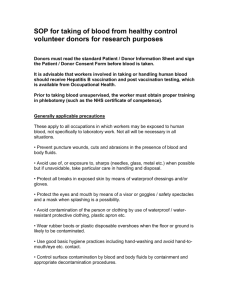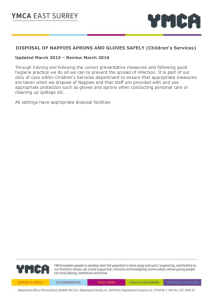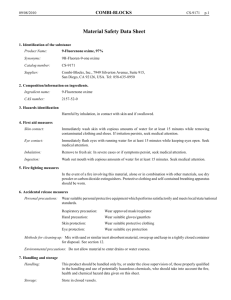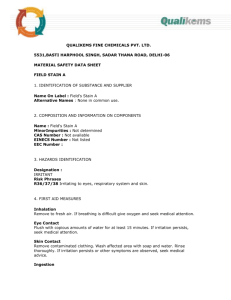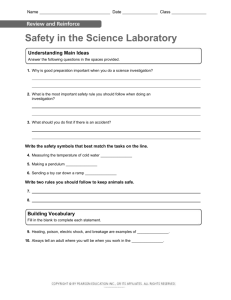Microbiology Safety Rules Laboratory
advertisement
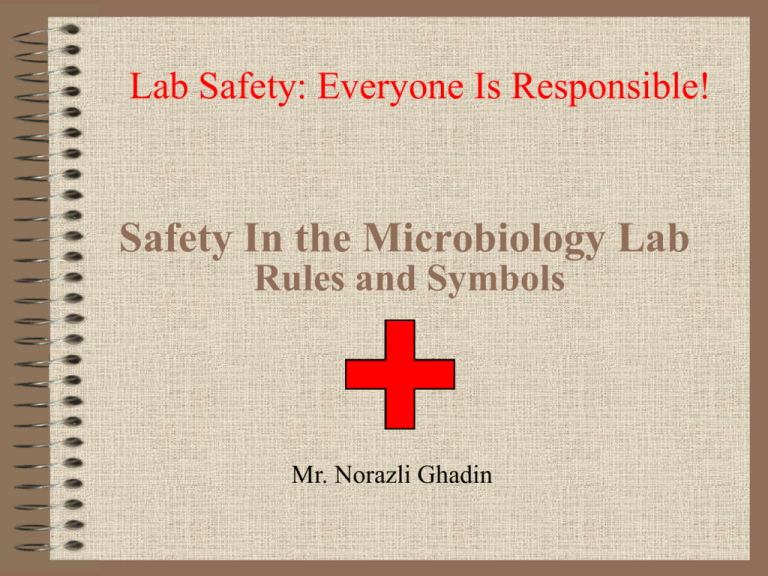
Lab Safety: Everyone Is Responsible! Safety In the Microbiology Lab Rules and Symbols Mr. Norazli Ghadin Lesson objectives • To know the general rules in microbiology lab • To know how to maintain aseptic condition • To know how to discard microbiological waste • To apply the rules when in the labs Importance of rules • Ensure safety of operator (YOUR SELF!!!!!!) • Safety of samples • Successful laboratory experimentation • Minimize hazards Routes of infection • Oral • Skin • Conjunctiva • Lungs General Safety Guidelines • Be Responsible at All Times. • Follow all instructions carefully. • No horseplay, practical jokes, pranks, etc. • Do not play with lab equipment until instructed to do so. • Food, drink, smoke and gum are not allowed in the microbiology lab . Lab Safety: Everyone Is Responsible! General Safety Guidelines • Don’t lick labels. • Don’t drink from laboratory glassware • Don’t wander about the laboratory; cause: – Accidents – Distract others – Promote contamination • Operate centrifuges, homogenizer and shakers safely • Immunize the laboratory workers General Safety Guidelines • Keep the microbiology lab clean and organized. • Notify supervisor immediately of any accidents or unsafe conditions in the microbiology lab ! • Wash your hands with soap and water after work. Lab Safety: Everyone Is Responsible! General Safety Guidelines • Listen to or read instructions carefully before attempting anything. • Wear safety goggles to protect your eyes from chemicals, heated materials, or things that might be able to shatter. • Notify your teacher if any spills occur. General Safety Guidelines • • • • Keep your hands away from your face. Tie back long hair away from shoulders . Wear glasses rather than contact lenses. Never put into your mouth – Pencils – Pens – fingers etc • Clean up your lab area at the conclusion of the laboratory period. General Safety Guidelines • • • • Roll up loose sleeves. Button-up your Lab Coat Lab coat thickening. Know the location of the fire extinguisher, Gas isolation switch, fire blanket, eyewash station, first aid kit & Exits. • Keep your work area uncluttered. General Safety Guidelines • Take to the lab station what is necessary, Left outside – Coats – Jackets – Bags and books not required for the laboratory session. • Cover any open cuts on hands and other exposed skin surfaces General Safety Guidelines • Wear mask N95 4 mycobacterium. • Do not wear any jewellery. • Carry out procedures to minimize risks of : – Spills – Splashes – Production of aerosols. • No slides or cultures are to be taken from, or brought into the lab without permission. General Safety Guidelines • Don’t use your Mobile. – Medical devices – Chemicals – With gloves – RF interference • Do not attend calls with gloves. • Writing – Without gloves – Working area General Safety Guidelines • Avoid wearing artificial nails • Keep natural nails <1/4 inch • Foot wear that completely covers the foot is required • No Open shoes • No rings or hand accessories • Do not wear loose clothing that could catch on fire • Do not open doors with glows PERSONAL PROTECTIVE EQUIPMENT and PROCEDURES • • • • • • Gowns Safety Glasses and Eye Protection Gloves Mask Hand washing High Risk Individuals /Antenatal Considerations Hand washing Chemical Safety • • • • • • Do not inhale the fumes. Never pour water into a concentrated acid. Wash hands. Wear goggles Lab apron Never taste any chemicals (never taste anything). Electrical Safety • Lay electrical cords where no one can trip on them or get caught in them. • hands dry before using electrical equipment. • Never poke anything into electrical outlets. • Unplug cords by pulling the plug and not the cord. • Unplug all electrical equipment at the end of the lab period. Heating Safety • Let burners and hotplates cool down before touching. • Use tongs and/or protective gloves. • Never reach across an open flame. • Wait until the striker is in place before you turn on the gas. • Heating a test tube, move it around slowly. • Dry glassware should be heated. • Do not hold it in your hand • Never leave a burner or hotplate unattended. Hypodermic syringes and needles • Common causes of occupational infections. – Collection – Processing – 25%. • Avoid quick & unnecessary hand movements. • Examine for chips and cracks, and needles for barbs and plugs. • Use needle locking syringes. • Wear gloves. • Fill syringes carefully to minimize air bubbles and frothing. Hypodermic syringes and needles • Expel air, liquid & bubbles vertically into a disinfected cotton swab. • Don’t forcefully expel into an open vial for mixing. • Mixing if the tip is held below the surface of the fluid. • Don’t manipulate by hand. • Place directly into a puncture-resistant container. • Decontaminate before – Disassembly – Reuse – Disposal. CLEANING & Waste Disposal • Separate the non-infectious from the infectious waste. • Dispose the infectious waste to – Minimizes the risk to both staff and students – Facilitates the recycling of reusable material. Sharps • “Yellow" sharps container at the back of each laboratory. – Needles – scalpel blades – other sharp materials • Always move the "sharps container" to your work place to dispose of such items. • Do not wander around the laboratory carrying sharps. Biogram Buckets • Containers of general purpose phenolic, hypochlorite (10 gm/L) laboratory disinfectant • Used for disposal of small contaminated items – used swabs – capillary tubes – wet slides – Pipettes – inoculated reagent strips – glass culture tubes. Biogram Buckets • Disposing pipettes, place tip first into the biogram • Not for Gram stains, non contaminated paper or matches. • 1/40 dilution of the commercial product 18% phenol equivalent. • Change weekly; or if grossly soiled. Biohazard Bin • Centre of each laboratory. • For the disposal of contaminated waste, e.g. – Used culture plates – Contaminated paper towel. • Not to be used sharps & Any non contaminated paper wastes. • Do NOT use these bins for – Paper towel discarded after hand washing – Blotting paper discarded after blotting slides. • autoclaved before disposal. • Left open to allow penetration of the steam Broken Glass • When any glassware is broken, notify the instructor immediately for assistance with disposal. – Non contaminated can be disposed of in the Billy cans – Contaminated should be placed into a stainless steel Billy and autoclaved prior to disposal in the glass bin. Sink • Don’t place any hazardous or infectious materials. • Don’t dispose of any solid material. REPORTING OF INCIDENTS • All accidents and major spills should be documented on an "incident report form" through the relevant Departmental Occupational Health and Safety Officer • Copies of any documentation relating to an incident or safety hazard must be sent to both MSO and a copy should also be retained. First Aid Injury: What To Do: Burns Immediately flush with cold water until burning sensation is lessened. First Aid Injury: Cuts, bruises What To Do: • Do not touch without gloves. • Pressing directly on minor cuts. • Apply cold compress to bruises to reduce swelling. First Aid Injury: Fainting To Do: Provide fresh air and have the person recline so that their head is lower than the rest of their body. First Aid Injury: Eyes What To Do: • Flush eyes immediately with plenty of water for several minutes. • If a foreign object is lodged in the eye, do not allow the eye to be rubbed. First Aid Injury: Poisoning What To Do: Find out what substance was responsible for the poisoning and alert the teacher immediately. First Aid Injury: Spills on the skin What To Do: Flush with large quantities of water. For acid spills, apply baking soda solution. For base spills, apply vinegar or boric acid. First Aid Injury: Electrical shock What To Do: • Shut off the current at the source. • Remove wire with rubber gloves. • Alert the teacher immediately. What’s Wrong With This Picture? What’s Wrong With This Picture? What’s Wrong With This Picture? What’s Wrong With This Picture? When in doubt – ASK!!! • Do not carry out a new or unfamiliar procedure until you have been fully trained & understand the precautions necessary for safe working • DO NOT GUESS!!!! HAZARDS SYMBOLS Explosive • Chemical that will rapidly burn and explode (Highly Flammable) • ‘Flash point’ – temperature where vopour of a solution will burn if ignited. • Solution with ‘Flash point’ < 32’c Oxidizing Substance • Chemical that readily release Oxygen. • Contoh: HNO3, KNO3, NaNO3, AgNO3 Toxix • Harmful chemical • Cyanide and mercury nitrate – nerve, kidneyte • ‘Iodine’ - lung and eye, initiate ‘impetigo’ • Formaldehyde (dalam Larutan 40% dipanggil ‘formalin’) – an irritant (corrosive) • All acid – burn tissue in contact. • NaOH and KOH – irritate, vomit and diarhea (irretant & Harmful) • Cylohexance, etanol, Methanol, Ethyl acetate, Butanol and Potassium dichromate - dermatitis. a dan b-Naphtol - skin irritant, damage kidney Naphthylamine - anesthetic some drawbacks, irritation pada mucous membrane Carcinogenic chemicals • carcinogens, mutagens, teratogens, respiratory sensitizers and substances with target organ toxicity. • Eg: • Ehtidium bromide, benzene Environmentally hazards • These substances damage or pollute the environment. Radiation hazards • Ionizing radiation • E.g: Uranium 235 • Rhodium isotope Biohazards • Living organisms that can cause infection • bacteria, fungus, virus Reference • • • • • • Food Standards Agency - Microbiological safety. html Guidelines on Standard Operating Procedures for MICROBIOLOGY Safety in Laboratories. tm WHO Microbiology Rules for Using Disinfectants eHow com. htmL Microbiology Safety and Staff Induction Manual University of Tasmania Launceston Campus Version 2, February 2000 Mrs. Page Kennedy Middle School 2002-2003 Presented by: Leonard LaFazia

